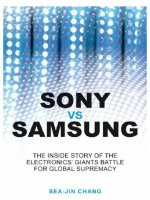Sony vs. Samsung: The inside story of the electronics' giants battle for global supremacy
Bạn đang xem bản rút gọn của tài liệu. Xem và tải ngay bản đầy đủ của tài liệu tại đây (3.03 MB, 490 trang )
Table of Contents
Title Page
Copyright Page
Preface
Chapter 1 - Sony and Samsung: Portraits of Two
Global Competitors
The Fall of Sony and the Rise of Samsung
Electronics
The History and Business Areas of Sony and
Samsung Electronics
Sony and Samsung Electronics’ Performance
Part 1 Strategic Analysis
Chapter 2 - Prince and Pauper in the Analog World
Sony, the Prince of Analog
The Late-Starter, Samsung Electronics
Chapter 3 - Digital Dream Kids and the Digital
Sashimi Shop
Digital Revolution
Sony’s Digital Dream Kids
Samsung Electronics’ Digital Sashimi Shop
Chapter 4 - New Kids on the Block
Sony’s Marketing Strategy: Focusing on New
Products
The Marketing Strategy of the Latecomer,
Samsung Electronics
Increasing Bargaining Power of Retailers
Chapter 5 - Wannabe Globals
Sony’s Global Strategy
Samsung’s Globalization Strategy
Problems with External Globalization
Part 2 Organizational Process and
Leadership
Chapter 6 - Same Silos but Different Outcomes
Sony’s Company Structure
Problem with Sony’s Organizational Structure
Corporate Culture and Organizational
Structure of Samsung Electronics
The Problem of Samsung Electronics’
Organizational Structure
Chapter 7 - From Founders to Professional
Managers
Sony’s CEO and Governing Structure
Problems with Sony’s Governing Structure
Samsung’s Powerful Owner-Centered
Structure
The Problems with Samsung’s Governing
Structure
Chapter 8 - The Future of S ony and Samsung
Electronics
Superficial Crisis and Internal Crisis
Lessons Learned by Sony and Samsung
Electronics
Endnotes
Glossary
Index
Copyright © 2008 by John Wiley & Sons (Asia) Pte. Ltd.
Published in 2008 by John Wiley & Sons (Asia) Pte. Ltd.
2 Clementi Loop, #02-01, Singapore 129809
All Rights Reserved
No part of this publication may be reproduced, stored in a retrieval
system, or transmitted in any form or by any means, electronic,
mechanical, photocopying, recording, scanning, or otherwise, except
as expressly permitted by law, without either the prior written
permission of the Publisher, or authorization through payment of the
appropriate photocopy fee to the Copyright Clearance Center.
Requests for permission should be addressed to the Publisher, John
Wiley & Sons (Asia) Pte. Ltd., 2 Clementi Loop, #02-01, Singapore
129809, tel: 65-6463-2400, fax: 65-6463-4605, e-mail:
This publication is designed to provide accurate and authoritative
information with regard to the subject matter covered. It is sold with
the understanding that the Publisher is not engaged in rendering
professional services. If professional advice or other expert
assistance is required, the services of a competent professional
person should be sought.
Other Wiley Editorial Offices
John Wiley & Sons, Inc., 111 River Street, Hoboken, NJ 07030,
USA
John Wiley & Sons Ltd., The Atrium, Southern Gate, Chichester
PO19 BSQ, England
John Wiley & Sons (Canada) Ltd., 5353 Dundas Street West, Suite
400, Toronto, Ontario M9B 6H8, Canada
John Wiley & Sons Australia Ltd., 42 McDougall Street, Milton,
Queensland 4064, Australia
Wiley-VCH, Boschstrasse 12, D-69469 Weinheim, Germany
Library of Congress Cataloging-in-Publication Data:
ISBN 978-0-470-82371-2
Typeset in 11-14 point, Minion Pro by Superskill Graphics Pte. Ltd.
Ltd.
Preface
This book emerged out of my own curiosity to
understand why Sony’s performance, which had
dominated the electronics industry for many
decades, had dropped so rapidly, while Samsung
Electronics, an obscure OEM (Original Equipment
Manufacturer) not so many years ago, had emerged
from nowhere. I must confess that I was one of the
admirers of Sony for its innovative products as
well as for its global management. I was fascinated
by the late Akio Morita’s book, Made in Japan,
and was impressed by his global mindset and
business acumen. This had led me to a research
project in 1994-1995 to examine the evolution of
Sony’s U.S. operation. I had opportunities to meet
with many outstanding managers and engineers at
Sony including Kunitake Ando, who then was a
head of its U.S. operation.
Sony was a role model for many Korean
companies, including Samsung Electronics, with
which I have maintained a close contact through
various projects, and a direct comparison between
these two would have been inappropriate at that
time. Ten years later, however, the fortunes of
these two companies changed dramatically. Sony’s
performance deteriorated, and Chairman Idei and
President Ando had to resign in 2005. On the other
hand, Jong-yong Yun, CEO, was applauded for
turning Samsung Electronics into one of the most
profitable companies in the electronics industry. I
felt compelled to find out what had caused their
changing fortunes.
Faced with the rapid digitalization of the
electronics industry, Sony and Samsung
Electronics had pursued rather different strategies.
Sony tried to create synergies between hardware
and contents by using the network. Samsung
Electronics, on the other hand, focused on its parts
business, and attempted to secure competitive
advantages in end products by being a superior
manufacturer. As I dug deeper in the analysis, I
became more convinced that the performance
differences between Sony and Samsung
Electronics could not be attributed to their
strategies. Rather, organizational processes and
executives’ leadership may have made the
difference. Sony’s independent business units
quickly became silos when its top management
leadership was questioned. Internal politics among
executives further exacerbated its stagnation. On
the other hand, the fit between Samsung’s strategy
in responding to commoditization with speed and
its militaristic organization may have contributed
to its stellar performance. I further examine the
challenges that Samsung Electronics faces, despite
its remarkable performance, and evaluate Sony’s
potential, despite its current struggles.
My endeavor to analyze key strategic decisions
by Sony and Samsung Electronics during the last
decade would not have been successful without the
assistance of Myoung-woo Lee, a 20-year veteran
of Samsung Electronics, and, more recently, the
president and chairman of Sony Korea. With his
unique vantage point of both companies, he not
only shared his own perspectives, but also
introduced me to executives and managers of both
companies for further interviews. I was fortunate
enough to have personal interviews with high-level
executives (including retirees) of both companies,
which would not have been possible without Mr.
Lee’s introductions. In addition, I had interviews
with security analysts and executives of other firms
in the electronics industry to get more objective,
external opinions. I would like to take this
opportunity to thank him for his contributions and
assistance.
I am also deeply indebted to several other
individuals and organizations. I would like to thank
Korea University for providing a special research
fund for this project to cover my frequent trips to
Japan. I also benefited from discussions with my
colleagues at Hitotsubashi University, where I
spent the summer of 2007 while preparing the
manuscript. John Lafkas, Kyung-hwan Yun, Sejung
Seo, Sang-hee Lee, Young-jae Koh, and Jung-
wook Shim provided very helpful editorial and
research assistance for the project. I would like to
thank Nick Wallwork, my editor at Wiley, and his
fellow staff members including Joel Balbin, Fiona
Wong, and Pauline Pek, as well as copyeditor Jay
Boggis, who all did a wonderful job of turning the
manuscript into a book. Last but not least, I would
like to thank the executives and managers at Sony
and Samsung Electronics who were willing to
share their valuable time to meet with me. I cannot
name them all here partly because there are too
many and partly because most wanted to remain
anonymous. I believe in management education. I
believe managers can learn from the experience of
other firms so that they will not repeat the same
mistakes and they can make better informed
decisions. Executives and managers from both
companies I interviewed were eager to share their
own perspectives. I would like to dedicate this
book to them.
Sea-Jin Chang
Philadephia
February 2008
1
Sony and Samsung: Portraits of
Two Global Competitors
Digital technology…
[presents] … the greatest
opportunity for those
manufacturers who did
not have a top market
share in the analog
world. If they make the
correct changes in
strategy, they possibly
could leap-frog well-
entrenched industry
leaders.
—Steve F. Smith, Editor-in-Chief, TWICE Magazine
Sony ruled a slower age
when it could bring out a
new gadget like the
Walkman as a luxury
item, then gradually
lower the price and
widen the market over
time. Now, since the rise
of cheap Asian
manufacturing in the
1980s, companies need to
bring out a stream of new
products that sell
immediately at high
volume for a relatively
low price, and are
quickly displaced by the
next new thing. Samsung
is king of this age.
—Newsweek
1
The Fall of Sony and the Rise of
Samsung Electronics
A Turning Point
A few years ago, the electronics industry reached a
milestone. Sony had long been acknowledged as
the world’s best electronics manufacturer, but in
2002, Sony’s market capitalization fell below
Samsung’s, which had been an obscure memory
chip producer not many years ago. Figure 1.1
shows some of the raw data behind this story. By
December 2006, Samsung’s market capitalization
was $106 billion, an increase of 400% since 2000
and twice that of Sony’s. Since becoming CEO in
1997, Jong-yong Yun, has become famous for
turning Samsung Electronics into one of the most
profitable companies in the electronics industry.
By contrast, Sony’s Chairman Nobuyuki Idei and
President Kunitake Ando resigned in 2005 and
were succeeded by Howard Stringer and Ryoji
Chubachi, respectively.
Figure 1.1 The Market Capitalization of Sony and
Samsung Electronics
Source: Samsung Securities, Sony Fact Book.
Sony began from a position of strength. The late
Chairman Akio Morita had shown the world that
Sony had become a global company. Michael
Porter, a strategy guru, praised Sony highly as one
of the few Japanese companies that actually had a
strategy.
2
Sony’s troubles began, however, after it
acquired Columbia Pictures in 1989 (see Figure
1.2). Things turned out so bad that by 1994 it had
to write off accumulated losses of $3.5 billion.
Sony then restructured its entertainment business to
control costs. Sony’s profitability peaked in 1997
when it introduced PlayStation, but started to
decline again soon afterward, and sales became
stagnant. By contrast, although Samsung
Electronics’ sales and profitability were highly
volatile during the late 1990s, its revenue almost
doubled between 2000 and 2006, and it had a
considerably higher rate of profitability than Sony
enjoyed during this period.
Figure 1.2 Sony and Samsung Electronics’ Sales
and Profitability (1991- 2006)
Source: Annual Reports and Earnings
Announcement of Sony and Samsung, respectively.
Sony’s fall appeared in the changing tones of
Sony’s top management whenever they spoke about
Samsung. Nobuyuki Idei noted in 2002 that
“Samsung found Sony a model or a benchmark for
their brand image. The product design and the
product planning—they have learned from us. So
Sony is a very good target for them.” To him,
Samsung was merely one of the suppliers rather
than a potential threat. He continued, “We still
believe that Samsung is basically a component
company.”
3
Just a year later, Kunitake Ando,
president of Sony, mentioned that he asked “for a
report on what Samsung is doing every week.”
4
In
2006, Sony’s newly appointed CEO, Howard
Stringer, said that “Samsung is a first-rate company
and they have a wealth of revenue coming from
other areas. But, I think in the high-definition
world, which is clearly our strategy for this year,
we still have an advantage.” Sony was now openly
acknowledging that Samsung Electronics had now
become its competitor.
5
Some of the popular press
even inflicted the ultimate insult on Sony by
commenting that it needed a lesson from Samsung.
“As he looks for inspiration, Stringer might
consider taking a page from Samsung Electronics.
The Korean company has taken many of the steps
that analysts believe Sony needs to take, ranging
from collaborating more with partners to doing a
better job taking its cues from the market. In doing
so, it has become one of the nimblest players in the
business.”
6
The Media Hype
Sony had once dominated the electronics industry.
So why did its fortunes drop so rapidly, just as
Samsung was emerging from out of nowhere? The
media have speculated about why the fortunes of
these two companies changed so rapidly, but their
evaluations are usually superficial and focus only
on short-term performance. Often, journalists
anoint a CEO as a Best Manager one year, only to
dub him the Worst Manager just a few years later.
Sony had been nominated as one of the “World’s
Most Admired Companies” by Fortune in 1997,
which commented that “Sony was voted the most
effective Asian company at doing business
globally, the best company in Asia at wooing and
winning topnotch people, and the most innovative
electronics company in the world. Since he took
over two years ago, Idei has shaken the place to its
foundations, revamping the board of directors,
restructuring major divisions, and clamping down
on U.S. operations—especially Sony Pictures
Entertainment.”
7
The magazine’s evaluation of
Sony and Idei soured, however, soon after the
firm’s performance deteriorated. Business Week
had nominated Idei as one of the World’s Best
Managers in 1997 and 1999. But in 2004, the
magazine put him on the World’s Worst list when
he triggered the so-called Sony shock by
announcing that the company had suffered a
quarterly loss of about $1 billion, which triggered









